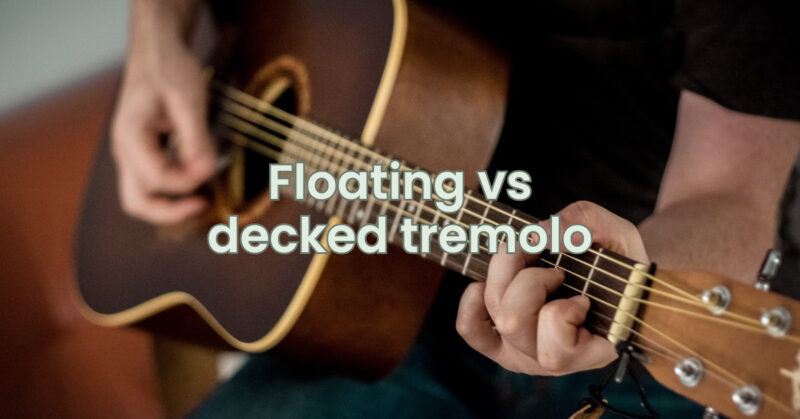The tremolo system is a beloved feature of electric guitars that allows players to add expressiveness, vibrato, and pitch modulation to their playing. When it comes to tremolo setups, two common options are the floating and decked tremolo. Each setup has its own characteristics, advantages, and considerations. In this article, we will explore the differences between a floating and decked tremolo and help you determine which option best suits your playing style and preferences.
Floating Tremolo:
A floating tremolo, also known as a “floating bridge” or “floating vibrato,” is a type of tremolo system that allows the bridge to pivot, enabling both upward and downward pitch modulation. The most well-known example of a floating tremolo is the one found on the Fender Stratocaster.
Pros of a Floating Tremolo:
- Increased Pitch Modulation: With a floating tremolo, you have the ability to raise and lower the pitch of notes using the tremolo arm. This allows for expressive techniques such as wide vibrato, dive bombs, and subtle pitch bends.
- Dynamic Tremolo Effects: The floating tremolo system provides a wide range of dynamic tremolo effects, adding depth and character to your playing. From subtle warbles to exaggerated dives, the floating tremolo opens up a world of sonic possibilities.
Cons of a Floating Tremolo:
- Tuning Stability: One of the challenges with a floating tremolo is maintaining tuning stability. Changes in string tension caused by bending, using the tremolo arm, or aggressive playing can cause the guitar to go out of tune more easily. Proper setup, regular maintenance, and careful playing techniques are necessary to mitigate these issues.
- String Action and Setup: Setting up a floating tremolo requires precise adjustments to achieve the desired string height, also known as the “action.” It can take time and patience to find the right balance between comfortable playing and avoiding unwanted string buzz.
Decked Tremolo:
A decked tremolo, also referred to as a “blocked tremolo” or “hardtail setup,” involves securing the tremolo bridge tightly against the body of the guitar, essentially immobilizing it. This setup removes the ability for upward pitch modulation but still allows for downward bends.
Pros of a Decked Tremolo:
- Improved Tuning Stability: Unlike a floating tremolo, a decked tremolo offers superior tuning stability. With the bridge blocked, string tension remains more consistent, reducing the likelihood of going out of tune, even during aggressive playing or heavy string bending.
- Simplicity and Ease of Use: Setting up a decked tremolo is generally easier and more straightforward. There are no moving parts or intricate adjustments required, making it a reliable choice for players who prefer a stable and hassle-free setup.
Cons of a Decked Tremolo:
- Limited Upward Pitch Modulation: By blocking the bridge, you sacrifice the ability to raise the pitch of notes using the tremolo arm. This restriction may limit your capacity for wide vibrato and other expressive techniques associated with upward pitch modulation.
- Reduced Tremolo Effects: Without the ability to raise the pitch, the range of dynamic tremolo effects is diminished. While you can still achieve downward bends, the decked tremolo setup doesn’t offer the same versatility as a floating tremolo.
Choosing the Right Tremolo Setup:
When deciding between a floating or decked tremolo, consider the following factors:
- Playing Style and Musical Preferences: If you frequently use upward pitch modulation techniques, require wide vibrato, or rely on dynamic tremolo effects, a floating tremolo may be the ideal choice. However, if you prioritize tuning stability and prefer a simpler setup, a decked tremolo offers a reliable and hassle-free option.
- Maintenance and Setup: Floating tremolos demand more precise setup and ongoing maintenance to ensure optimal tuning stability. If you prefer a more straightforward and stable setup that requires less maintenance, a decked tremolo may be a better fit.
- Experimentation: If you’re uncertain which tremolo setup suits your playing style, consider experimenting with both options. Many guitars with floating tremolos can be decked by blocking the bridge, allowing you to experience both setups and make an informed decision.
Conclusion:
Choosing between a floating or decked tremolo depends on your playing style, desired tonal characteristics, and preference for pitch modulation techniques. While a floating tremolo offers greater pitch modulation and dynamic tremolo effects, it requires careful setup and maintenance to maintain tuning stability. On the other hand, a decked tremolo provides superior tuning stability and simplicity but sacrifices upward pitch modulation. Ultimately, the decision comes down to personal preference and the specific demands of your playing style.


